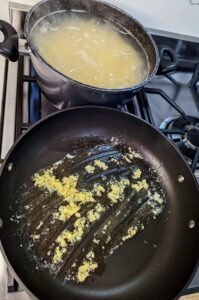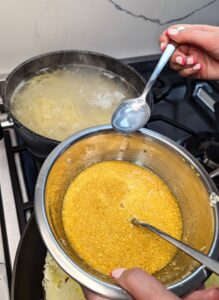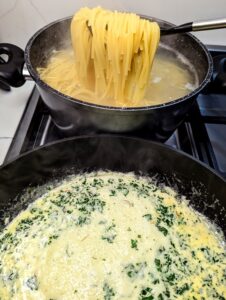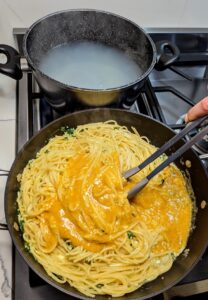
A sauce as creamy and rich as this deserves a wine with equal oomph. Therefore, go for a Chardonnay that has spent some time in oak barrels or on lees (look for these terms in the description on the wine bottle).
The simplest recipes are often the most difficult to perfect. While not completely traditional, this recipe makes carbonara simple and minimises the risk of the eggs overcooking. The results are a silky, rich and decadent sauce.

Servings
2 Servings

PREP TIME
10 mins

COOK TIME
15 mins

TOTAL TIME
25 mins

Difficulty
Easy

Wine pairing
Chardonnay
1. Add the eggs, parmesan, salt and pepper to a small bowl and whisk to combine. Set aside until required or refrigerate if you’re doing this step in advance, but remove from the fridge 30 minutes before needed so it’s not fridge-cold.
Note: This recipe assumes you’re using dry pasta with a standard cook time of about 7-10 minutes. If you’re using fresh pasta with a shorter cook time, crisp the pancetta first and begin cooking the pasta at the same time as the sauce.
1. Fill a medium sized pot with water and place over high heat. While you’re waiting for the water to boil, make a start on step 3 (crisp the pancetta).
2. When the water comes to a boil, add the pasta and stir with a fork every minute for the first few minutes so that the pasta doesn’t stick together. Then, make a start on the sauce – timing is crucial so the sauce is ready by the time the pasta finishes cooking.
Important: Do not drain the pasta water when the pasta is finished cooking, as the sauce needs some of the pasta water to thicken.
1. Meanwhile, crisp the pancetta in one of the following ways:
2. Put the crisped pancetta aside until serving. If you want to keep it warm for serving, place it in a heatproof bowl in the oven at a low temperature.
1. Melt the butter in a frying pan over low to medium heat. Then add the garlic and the saffron and saute for about 2 minutes. If the garlic starts to brown, move to the next step.

2. Add the cream to the pan and stir to combine. Turn the heat to low.
3. Check on the pasta; by now, it should be nearly al dente. You want the pasta to have a little bit of bite left, as it’s going to continue cooking in the sauce.
4. Grab the bowl with the egg mixture and add 3 tablespoons of pasta water to it, 1 tablespoon at a time, stirring straight away between each addition. Then set the bowl aside.
Tip: This step tempers the egg so it won’t scramble as soon as it hits the hot pan later on. Adding the hot water one tablespoon at a time and stirring in between will ensure the eggs don’t start cooking when the hot water is added.

5. Use tongs or a spaghetti spoon to transfer the pasta from the water to the frying pan. Don’t worry about draining the pasta too well – we want some of the pasta water in the sauce to thicken it. Also, don’t drain the pasta water yet in case you need more water for the sauce later on.

6. Ensure the frying pan is on the lowest possible heat, and add the egg mixture. Using tongs, constantly stir the mixture (don’t stop!) until it starts to thicken and coat the pasta.
Tip: Do not stop stirring for more than a moment or the eggs will start scrambling.

7. Assess the sauce – if you want more sauce or if it’s too thick, add up to 1/3 cup additional pasta water.

8. Serve the carbonara in pasta bowls with some extra cracked pepper and extra shaved parmesan. Finally, crumble the crisped pancetta over the top just before serving.


A sauce as creamy and rich as this deserves a wine with equal oomph. Therefore, go for a Chardonnay that has spent some time in oak barrels or on lees (look for these terms in the description on the wine bottle).
